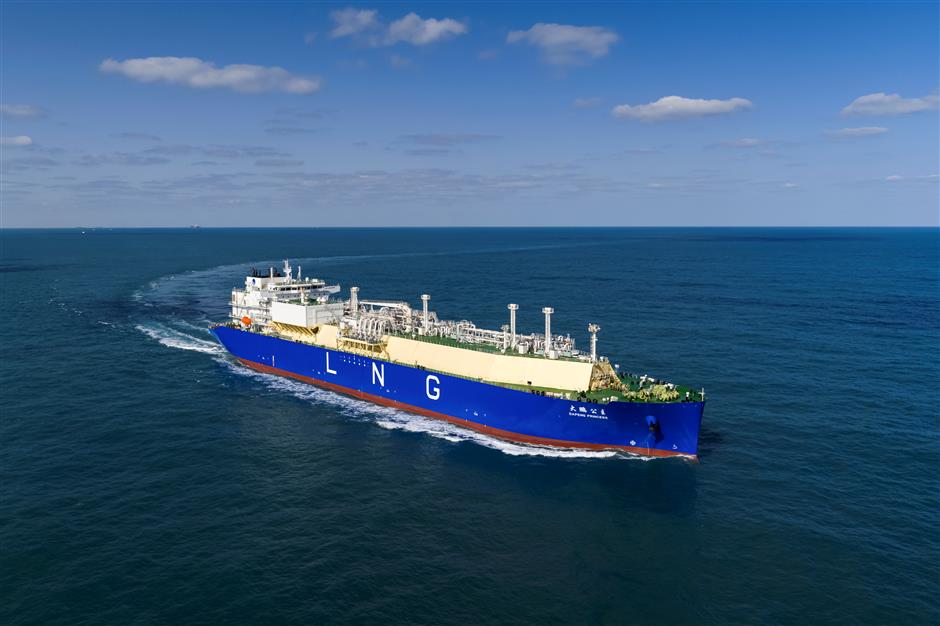Anchors aweigh! Building larger, greener and more intelligent ships

An LNG carrier under construction at the shipyard of Hudong-Zhonghua.
South Korea, a rival with China in global shipbuilding, recently issued a new round of initiatives to support its industry, including more government investment in new technologies, expanded foreign-worker programs and new financial support.
"Growing competition" was cited when the plans were announced.
Indeed, a rebound in the global industry has the two market leaders in a fierce battle to build larger, greener and more digitally "smart" vessels.
In terms of "compensated gross tons," a measure of the amount of work needed to build a ship, China retained its market leadership in 2022, according to UK-based maritime researcher Clarkson Research.
However, in terms of "high value" vessels, like liquefied natural gas (LNG) carriers, South Korea retains its domination, but China is quickly catching up.
Chinese shipyards received about 30 percent of the global orders for LNG carriers last year, a big increase from about 10 percent market share the previous year and years before.
Its foreign orders are getting more high-profile. In 2020, Qatar Petroleum and Shanghai-based Hudong-Zhonghua Shipbuilding Group signed a deal for Qatar's first LNG vessel from a Chinese company. Hudong-Zhonghua is a subsidiary of China State Shipbuilding Corp, the world's largest shipbuilder.
"Chinese shipbuilders are catching up in terms of high-value vessels in recent years, and that trend is likely to continue despite the volatility in shipbuilding orders," Ji Yongbo, project manager of the digitization institute at Hudong-Zhonghua, told Shanghai Daily.
"That is due," he said, "not only to an industry rebound in the last two to three years, but also to China's solid supply chain in shipping, its maturing natural gas industry chain and its overall new energy strategies."
Hudong-Zhonghua, a leading LNG vessel builder in China, started delivering LNG carriers in 2008.

The world's largest river-sea intermodal LNG carrier was delivered by Hudong-Zhonghua in February.
Last year, it received a record 38 new orders, accounting for more than 22 percent of global market share – a sizeable increase from less than 7 percent in 2021.
An LNG carrier is one of the most intricate and demanding vessels to build.
To minimize the amount of LNG lost during gas transport, the product is either frozen and maintained below minus-163 degrees Celsius or it is compressed. Both techniques require specialized materials, advanced technologies and complicated processes.
"The expertise and technology in LNG shipbuilding also help with other eco-friendly vessel projects, including the transition to hybrid use of energy," Ji added.
He cited continuous upgrades and development of the company's own ship production design system, and development of new digital technologies that help break the rules of traditional manufacturing.
The International Maritime Organization has adopted standards calling for a 40 percent reduction in carbon intensity by 2030 and 70 percent by 2050, compared with the level in 2008.
With an average ship lifespan of about 25 years, that means ships not meeting the standards will have to be refitted or mothballed in the coming years.
A shipbuilding industry strategy released by South Korea last year focuses on eco-friendly ships, throwing down the gauntlet for China to follow suit.
Chinese shipyards like Hudong-Zhonghua have been quick to rise to the challenge. The company said earlier this year it would double construction capacity for eco-friendly LNG carriers in the next few years.
In February, it delivered an 80,000-cubic-meter LNG carrier, the world's largest carrier of its type that can navigate both ocean and river waterways.
Chinese shipyards are also exploring ways to break into other vessel construction sectors, including large cruise ships.
LNG carriers, aircraft carriers and cruise ships are generally considered the most difficult and intricate projects in the shipbuilding industry.
Large cruise ships, also known as floating cities, require millions of parts from thousands of suppliers.
China's first domestically built cruise ship, which is being built at the Shanghai Waigaoqiao Shipyard, was named "Adora Magic City" on Friday, and expected to hit the waters by the end of 2023.
The 135,500-ton ship has a capacity of 5,246 passengers and a length of 323.6 meters.
A second and larger cruise is already in construction.
According to the company, large cruise ships like "Adora Magic City" require 25 million parts, which is about five times more than China's domestically manufactured passenger jet C919 or 13 times that of a bullet train.
"The trend is toward larger, greener and more intelligent ships in the global industry," Ji concluded. "We are definitely working toward that direction."

A model of the first domestic cruise ship















